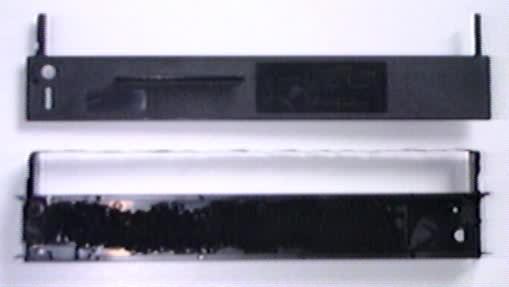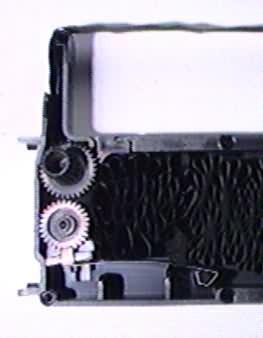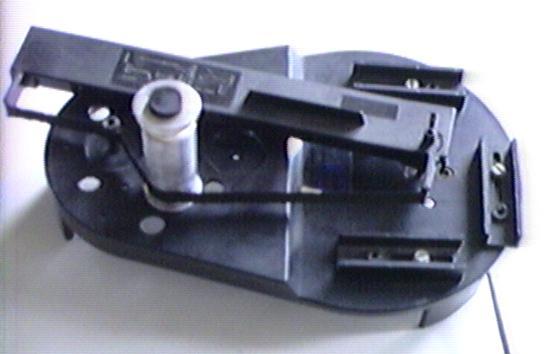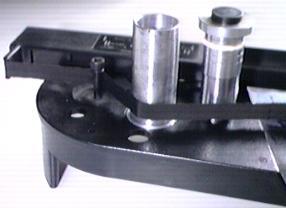Reinking printer ribbons
Besides environmental benefits, reinking printer ribbons can result in considerable savings: the cost of reinking is usually 20% of the purchase price of a new one or lower. When done in larger numbers prices can go down even further. This also allows for more professional equipment, though DIY will do well for smaller numbers.
Ribbons
The ribbon as used in the PCW 8000 matrix printer is a standard model: commonly known as the Seiskosha SP 800/1000. The standard length is 14 meter (15 yds.) although there was a shorter version around, marketed by Amstrad itself. The model shown is a standard one, from Pelikan, which retailed for about NLG 15.- (EUR 6.81).

The cover has been removed to show the 14 meters of (endless) ribbon, winded up inside the case.

The mechanism of the ribbon is very straightforward and does not suffer much from technical malfunctions. Its quality, on the 9 pins dot matrix as used on the PCW 8000 series, is good, especially in quadruple printing mode (e.g. produced by MicroDesign III).
The quality of the output can be manipulated with two simple tricks:
These tricks will expand the time that the output quality is acceptable but can also shorten the lifetime of the ribbon, due to the resulting increased wear. Sometimes ribbons are no longer fit for reinking: judging this is a matter of experience. Large or irregular meshes in the nylon pattern are indications that reinking will not result in acceptable hard copies. This can be seen from the nylon material: if it is too transparent it may be worn or dried out. Quality brands can usually be recycled up to a dozen times, though several ribbons have exceeded that number by farů

Ribbons for the daisywheel printer, as supplied with the PCW 9512 (Olympia model Carrera II), are usually of carbon type and cannot be reinked. They are of single pass type only (the photograph clearly demonstrates that), more expensive but they provide a higher quality than the nylon type. As the daisy wheel printer is a typical text printer, the width of the ribbon is smaller than the 8000 variant: there is no need to exceed the height of one line space. The height is therefore 8mm (5/16"), compared to 13mm (1/2") on the matrix printers. The length of the Olympia is typically 19.5 meter (211yds.), again a specimen from Pelikan. Other models of the PCW series have inkjet printers (typically Epson or Canon) that can also be reinked, but I am not in favour of that: the mechanism of an inkjet printer is (even) more delicate than a matrix printer and the ink is actually injected through the printer instead of 'hammered out the ribbon' through pins.
MacInker

The machine the JCC used to use (we discontinued the service in 2010) for reinking was a semi-professional one: it was of simple but robust design and could deal with various types of ribbons for typewriters, matrix or daisy wheel printers. It had a removable axis that could turn left or right, dependable on the requirements of the ribbon. The ink reservoir, a metal cylinder, has three perforations that allow the ink to seep out and drain the ribbon that is guided along the reservoir.

A second inner-cylinder, separately shown on the picture right, that does not have perforations (except an air hole on top to allow ink to flow out of the other cylinder), regulates the number of holes opened, thus allowing for the height of the ribbon as well as preventing the ink from drying-out. The 8000 ribbon (13mm) requires two holes opened and needs an inking process of approximately 20 minutes. Of course, the time depends on the speed of the motor, but faster rotations will result in less ink-absorption by the ribbon.

Sealing reinked ribbons is a must in order to keep the quality and prevent drying-out.
DIY

Do-it-yourself is not very hard but you do need the proper ink for the purpose: especially matrix printers require the prescribed ink, increase of wear, deteriorated quality or defects may result otherwise. The ink is typically very thick and resembles oil, rather expensive stuff. Besides the evasion of damage, the results when using the appropriate ink are much better.
Other than that do-it-yourself is possible and inexpensive: constructing a device that reproduces the described MacInker or a similar device is not that hard. Spray cans that should do the job are around too, but I would not recommend them: the environmental benefits are zero, they are more expensive and, perhaps most important to the user, they are somewhat clumsy to use. Achieving an even spread requires a steady hand and winding the ribbon is a must, though some manufacturers claim that spraying from the top on a rolled-up ribbon (cover removed, as shown earlier) will do the job. Furthermore, I have my doubts about the quality of spray ink, when I look at the viscosity of the ink we usedů Various colours of ink are possible, but the original ribbon should have the same colour (or be a blank one: blank nylon tape can be obtained but sewing the ends to produce and endless ribbon is tricky if you do not want loss of quality on the seams).
This section will be expanded soon with a paragraph on printer maintenance (PCW 8256/8512/9512).